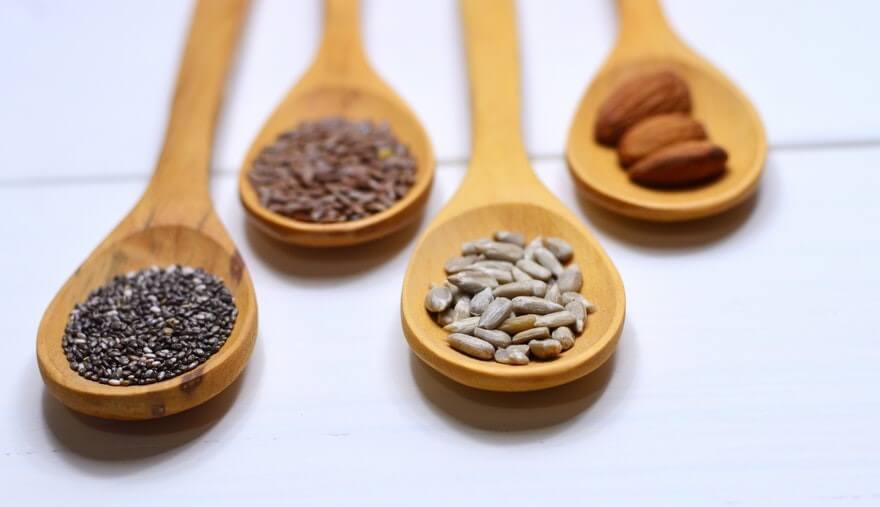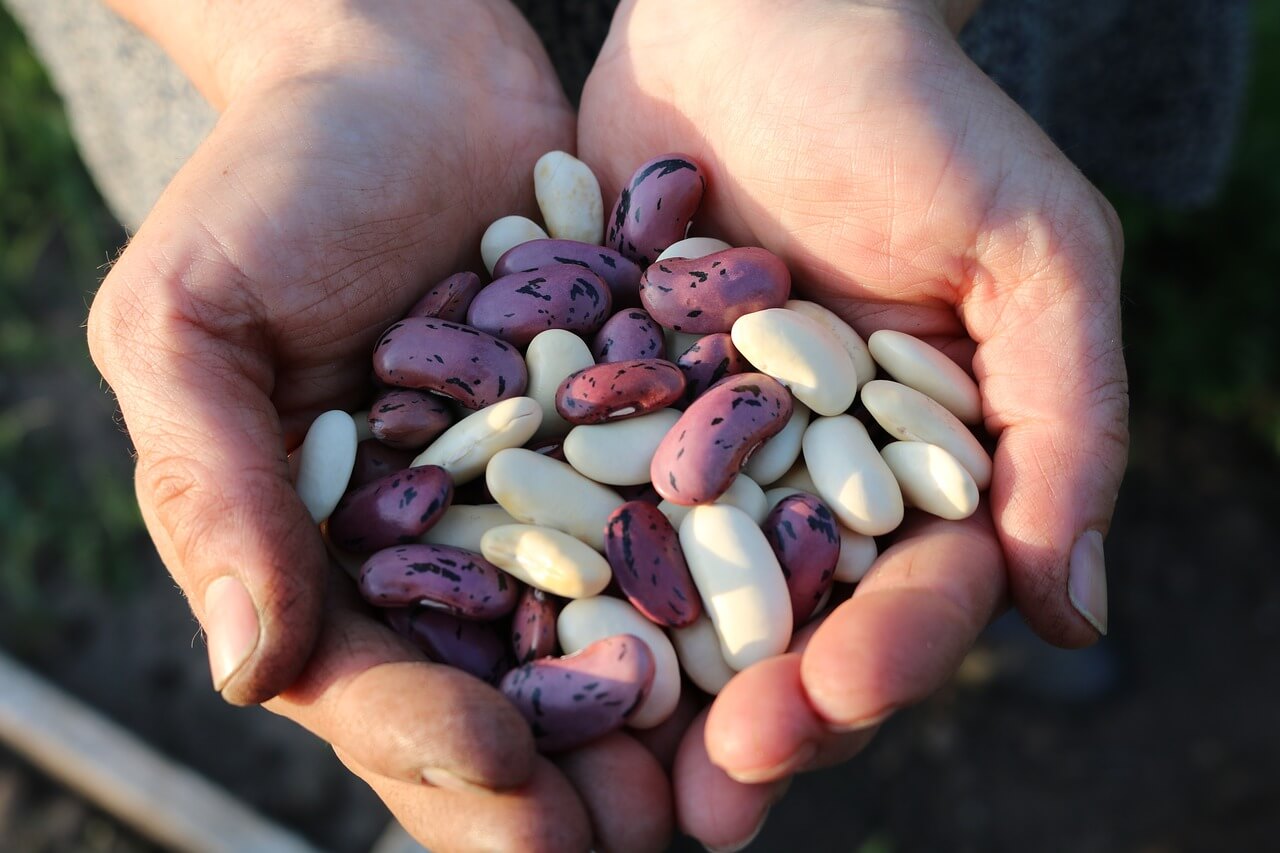Whether you’re just a bit gluten intolerant, or you have Celiac disease, getting enough protein on a vegan gluten-free diet requires a bit more planning.
The good news is that a lot of the best vegan protein sources are still gluten-free, you’ll just need to prioritize whole foods versus pre-made meat substitutes.
We’ll look at the most common foods with gluten, and then go over which foods you should focus on instead.
Table of Contents
The Most Common Vegan Protein Sources With Gluten in Them
A gluten-free vegan diet is less constricting than a paleo vegan diet at least.
The main protein sources that you’ll need to avoid are:
- Vital wheat gluten – Used in many mock meat substitutes. Note that Beyond products do not currently use wheat gluten (they use pea protein instead as a base).
- Wheat flour
- Rye flour
- Barley
But that’s most of it.
Aside from pre-made vegan foods, most whole foods on a vegan diet are already gluten-free, which is great news.
However, gluten also can sneak up in some places like soy sauce, and even tofu and tempeh can have gluten in it (depends on the brand for all of these). So just always double-check ingredient lists before buying something.
Good Vegan Protein Sources Without Gluten (Table)
Here’s a table of the top vegan protein sources that are gluten-free, which I’ve tried to make as comprehensive as possible.
You can sort by either the amount of protein per 100 grams or per 100 calories.
| Food | Protein (g) per 100g | Protein (g) per 100 calories |
|---|---|---|
| Seaweed (dried) | 57.4 | 20.1 |
| Hemp seeds | 31.6 | 5.7 |
| Peanuts | 25.8 | 4.5 |
| Almonds | 21.1 | 3.6 |
| Pistachio nuts | 20.2 | 3.6 |
| Pumpkin seeds | 18.5 | 4.2 |
| Tempeh* | 18.5 | 9.6 |
| Flaxseed | 18.3 | 3.4 |
| Sesame seeds | 17.7 | 3.1 |
| Oats | 16.9 | 4.3 |
| Chia seeds | 16.5 | 3.4 |
| Cashew | 15.3 | 2.7 |
| Walnut | 15.2 | 2.3 |
| Hazelnut | 14.9 | 2.4 |
| Brazil nut | 14.3 | 2.2 |
| Pine nuts | 13.7 | 2.0 |
| Soybeans | 12.4 | 8.8 |
| Buckwheat groats | 11.7 | 3.4 |
| Lentils | 9.0 | 7.8 |
| Black beans | 8.9 | 6.7 |
| Chickpeas | 8.9 | 5.4 |
| Kidney beans | 8.7 | 6.8 |
| Navy beans | 8.2 | 5.9 |
| Tofu (firm)* | 8.2 | 11.7 |
| Fava bean | 7.6 | 6.9 |
| Adzuki beans | 7.5 | 5.9 |
| Mung bean | 7.0 | 6.7 |
| Lima beans | 6.8 | 5.5 |
| Garlic | 6.3 | 4.8 |
| Peas | 5.4 | 6.7 |
| Quinoa | 4.4 | 3.7 |
| Amaranth | 3.8 | 3.7 |
| Collard greens | 3.5 | 12.0 |
| Corn | 3.3 | 3.8 |
| Artichoke | 3.3 | 7.0 |
| Cowpeas | 3.2 | 3.3 |
| Rapini | 3.2 | 14.3 |
| Kale | 2.9 | 8.2 |
| Spinach | 2.9 | 12.5 |
| Mustard greens | 2.9 | 10.7 |
| Broccoli | 2.8 | 8.3 |
| Rice | 2.7 | 2.1 |
| Water spinach | 2.6 | 13.3 |
| Lotus root | 2.6 | 3.5 |
| Arugula | 2.6 | 10.4 |
| Brussels sprouts | 2.6 | 7.1 |
| Guava | 2.5 | 3.8 |
| Asparagus | 2.4 | 11.1 |
| Watercress | 2.3 | 19.0 |
| Farro | 2.2 | 2.5 |
| Okra | 1.9 | 5.9 |
| Cauliflower | 1.9 | 7.6 |
| Green bean | 1.8 | 5.9 |
| Swiss chard | 1.8 | 9.5 |
| White potato | 1.7 | 2.4 |
| Beets | 1.7 | 3.8 |
| Bamboo shoot | 1.5 | 12.9 |
| Bok choy | 1.5 | 11.7 |
| Leek | 1.5 | 2.5 |
| Turnip greens | 1.5 | 4.6 |
| Apricot | 1.4 | 2.9 |
| Blackberry | 1.4 | 3.2 |
| Lettuce (red leaf) | 1.3 | 10.3 |
| Cabbage | 1.3 | 5.2 |
| Squash | 1.2 | 7.5 |
| Zucchini | 1.2 | 7.1 |
| Raspberry | 1.2 | 2.3 |
| Gourd | 1.2 | 5.9 |
| Lemon | 1.1 | 3.8 |
| Napa cabbage | 1.1 | 9.2 |
| Onion | 1.1 | 2.7 |
| Nectarine | 1.1 | 2.4 |
| Red bell pepper | 1.0 | 3.8 |
| Eggplant | 1.0 | 3.9 |
| Carrot | 0.9 | 2.2 |
| Peach | 0.9 | 2.3 |
| Grapefruit | 0.9 | 2.4 |
| Tomato | 0.9 | 4.8 |
| Green bell pepper | 0.9 | 4.3 |
| Cantaloupe | 0.8 | 2.5 |
| Pummelo | 0.8 | 2.0 |
| Lime | 0.7 | 2.4 |
| Celery | 0.7 | 4.9 |
| Strawberry | 0.7 | 2.1 |
| Radish | 0.7 | 4.0 |
| Cucumber | 0.7 | 4.3 |
*Indicates that a food could have gluten in it
Even without wheat, there are still some grains like oats and buckwheat (not actually related to wheat) that are gluten-free in most cases.
The Best Gluten-Free Vegan Protein Sources
You’ll want to focus the most on these types of plant foods.
Seaweed
Seaweed comes in several varieties and is considered a “superfood” because of its high vitamin and mineral content. It’s also very high in protein.
The most common seaweed products you’ll find in stores are:
- Kelp
- Nori
- Kombu
- Arame
- Chlorella
Unfortunately, you can only eat so much seaweed.
So eat seaweed snacks and incorporate it into your recipes when possible, but it won’t make up the majority of your protein intake.
Seeds

Seeds are one of the best vegan sources of healthy fats and protein, and also contain a lot of essential minerals.
You’ll see several seeds on the list above, including:
- Flaxseed
- Sesame seeds
- Chia seeds
- Pumpkin
While seeds don’t really form the base of a meal, they can be added to a wide variety of salads, soups, and even oats.
Nuts
Most vegans should eat some nuts on a regular basis.
They’re a good source of protein, and also have some minerals. Many of the best protein sources above are nuts, including:
- Almonds
- Pistachio nuts
- Cashew
- Walnut
- Hazelnut
- Brazil nut
- Pine nuts
But you do want to limit your nut intake a bit.
First, they are very high in calories due to their fat content.
Secondly, most nuts have a poor omega 3 to 6 fat ratio. Getting too many omega 6 fats can lead to inflammation.
Legumes

Legumes are the most balanced plant protein source. They are relatively high on the list whether you sort by amount of protein per 100 grams or per 100 calories.
That’s why legumes should be a main part of any vegan athlete’s diet that requires a relatively high amount of protein. There’s no real concern over eating a lot of legumes.
Pretty much any legume has a decent amount of protein, but the best ones are:
- Peanuts
- Lentils
- Black beans
- Chickpeas
- Kidney beans
There are tons of high protein vegan recipes with beans in them, from chilis to salads.
How to Get Enough Protein on a Gluten-Free Vegan Diet
In a practical gluten-free vegan diet, you should focus on including the above types of plant protein in your diet as much as possible.
There’s a few other things to consider that will make your life easier:
- Protein powder – Most protein powder is gluten-free and is based on pea protein. It’s an easy way to add 20-40 grams of protein per day. If you need a recommendation, here’s my thoughts on the best vegan protein powders.
- Protein bars – Most protein bars are also gluten-free, just check the package before buying one. They don’t have quite as much protein as protein powders, but are good snacks. Here are the best vegan protein bars in my opinion.
- Vegan gluten-free recipes – There are many gluten-free vegan blogs out there with recipes that can make your life easier. One of my favorites is Simple Veganista, who has over 250 vegan and gluten-free recipes.
FAQs
Are oats always gluten-free?
Oats themselves are naturally gluten-free, but they are often processed in facilities that also handle wheat and other gluten-containing grains. This cross-contamination during processing can introduce gluten into oats, making them unsuitable for those with celiac disease or gluten sensitivity.
If you require gluten-free oats, it’s essential to look for products labeled as “certified gluten-free.” These oats are grown, processed, and tested to ensure they meet specific gluten-free standards. Certified gluten-free oats are a safe option for individuals who need to avoid gluten.
Does all seitan contain gluten?
The main ingredient in all seitan products is vital wheat gluten, which is literally the gluten protein (along with other proteins) extract from wheat. In other words, there is no seitan that is gluten-free by definition.
Which vegan foods should in theory be gluten-free but might not be?
While many vegan foods are naturally gluten-free, there are certain products that might not be due to cross-contamination during processing. It’s important to check labels and look for gluten-free certifications if you have gluten sensitivity or celiac disease. Some examples include:
- Plant-Based Meat Alternatives
- Vegan Cheese
- Processed Vegan Foods
- Sauces and Condiments
- Baked Goods
- Vegan Protein Bars
- Vegan Snack Foods
